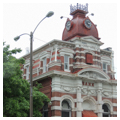You are here
Peoples’ National Bank
McLeansboro, like so many of the county seats in Illinois, has a large town square with a courthouse in its center. This prosperous county seat once bubbled with the activity of numerous mills, a dozen or more retail stores, a railroad stop, and nearby coal mines. While the square is lined with many fine, but typical nineteenth-century commercial buildings, one in particular stands out—the remarkable Cloud State Bank.
The bank was founded in 1871 by Chalon Guard Cloud and his cousin Chalon Guard McCoy as the Hamilton County Bank. In 1880 the Cloud family hired the Reid Brothers of nearby Evansville, Indiana, to design a solid and impressive new building unlike anything else in this part of Illinois.
The building is small—30 x 90 feet—but its exuberant Second Empire facade and roofline still dominate McLeansboro’s courthouse square. The front elevation is symmetrical: red brick walls with a limestone base, tall round-arched windows flanking an inset entrance, and a mansard roof with a central tower. The emphatic limestone quoins and blocked Corinthian columns are topped by a deep entablature with heavy, molded swags and a central urn above the round-arched, inset entryway. A segmentally arched pediment over the central bay is ornamented with additional floral carvings and a central rondel. Deep eaves are supported on floral modillions. On the south side, the tall round-arched windows of the main banking room are continued down the side, separated by brick pilasters with limestone trim. Also on the south elevation, two chimneys balloon out into decorative tops.
The entire building is crowned with a richly detailed mansard roof that includes a series of segmentally arched dormers with Corinthian pilasters, multi-colored slate roofing, and another set of modillion-supported eaves. The bank’s entrance is given a strong finish with a central tower that rises up through a pedimented pavilion to a steep mansard roof containing decorative clock faces and wrought-iron cresting. Inside, the 25-foot-high frescoed ceiling is long gone, but it is still possible to sense the solemn and secure atmosphere of the original banking hall with its centrally located vault.
Aaron Cloud also hired the Reid Brothers to design his house, located on the corner adjacent to the bank. Also built in 1880–1884, the house was as lavish as its commercial neighbor. Deeded to the city by Cloud’s daughter in 1921, today it serves as the McCoy Library.
McLeansboro suffered considerable losses beginning in 1925, when the destructive Tri-State Tornado blew through town, and continuing into the 1930s when, like much of the rural Midwest, it was hit hard by the Great Depression. Today, the town square is no longer the lively place it was at the end of the nineteenth century, despite the continued presence of the Hamilton County Courthouse and the surrounding commercial buildings.
References
Carr, Hazel R., “The Cloud State Bank,” Hamilton County, Illinois. National Register of Historic Places Inventory–Nomination Form, 1971. National Park Service, U.S. Department of the Interior, Washington, D.C.
Writing Credits
If SAH Archipedia has been useful to you, please consider supporting it.
SAH Archipedia tells the story of the United States through its buildings, landscapes, and cities. This freely available resource empowers the public with authoritative knowledge that deepens their understanding and appreciation of the built environment. But the Society of Architectural Historians, which created SAH Archipedia with University of Virginia Press, needs your support to maintain the high-caliber research, writing, photography, cartography, editing, design, and programming that make SAH Archipedia a trusted online resource available to all who value the history of place, heritage tourism, and learning.










